
5 Things to Know About Measles
To protect yourself from measles and to help educate patients about the importance of immunizations, you should be familiar with vaccination recommendations.
To protect yourself from measles and to help educate patients about the importance of immunizations, you should be familiar with vaccination recommendations. Here are 5 things to know about measles.
1. IMMUNIZATIONS
As a clinician, you interface with a diverse patient population, many who may have opted out of receiving the measles vaccine. A May 30, 2019 US Centers for Disease Control and Prevention bulletin reported the US was experiencing its highest level of measles cases since 1992 with a total of 971 cases. To keep yourself safe, stay current with immunizations including the measles, mumps, and rubella (MMR) vaccine.
2. CLINICAL SIGNS
Measles typically begin with a fever as high as 104°F or more that lasts for 4 days to 7 days, and patients may present with the 3 C’s: cough, coryza, and conjunctivitis. A rash will erupt on the face, head, and neck 14 days after exposure to the virus, and within 48 hours the lesions will appear as patches on a person’s trunk and extremities. The virus can also lead to ear infections, diarrhea, and pneumonia. If a patient presents with signs and symptoms of measles, do not proceed with oral health care treatment. Refer the patient to his or her primary care physician.
3. ORAL SIGNS
Oral manifestations include Koplik’s spots on the buccal mucosa, labial mucosa, and soft palate. These small, blue-white macules surrounded by erythema appear 1 day to 2 days prior to the skin rash. Candidiasis, necrotizing ulcerative gingivitis, and necrotizing stomatitis are also associated with the virus.
4. POST-EXPOSURE
The dental office must notify the state Department of Health if a patient with a case of measles was in the office, because it is a notifiable disease.
5. ADVOCATING FOR VACCINATIONS
There are several reasons why parents and adults may choose to not have their child, or themselves, vaccinated. Presenting these patients with educational and informative resources on the safety of the vaccine is paramount to reducing the spread of measles in the US.
Use the buttons below to share these tips with your friends and colleagues!

